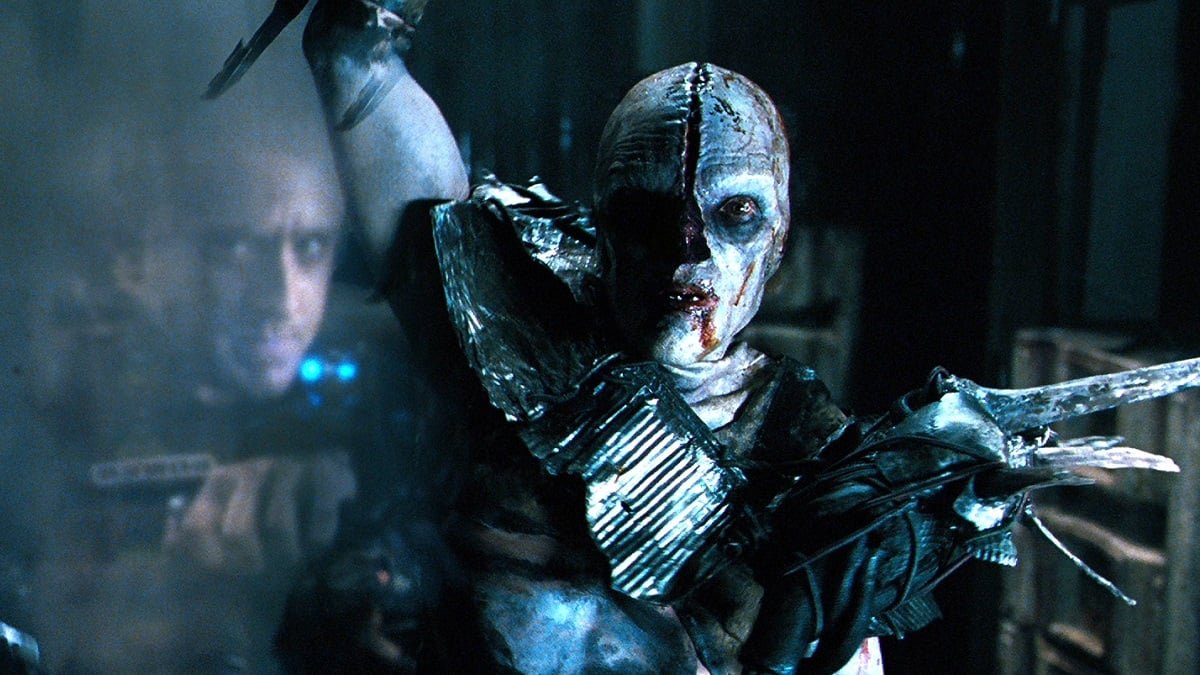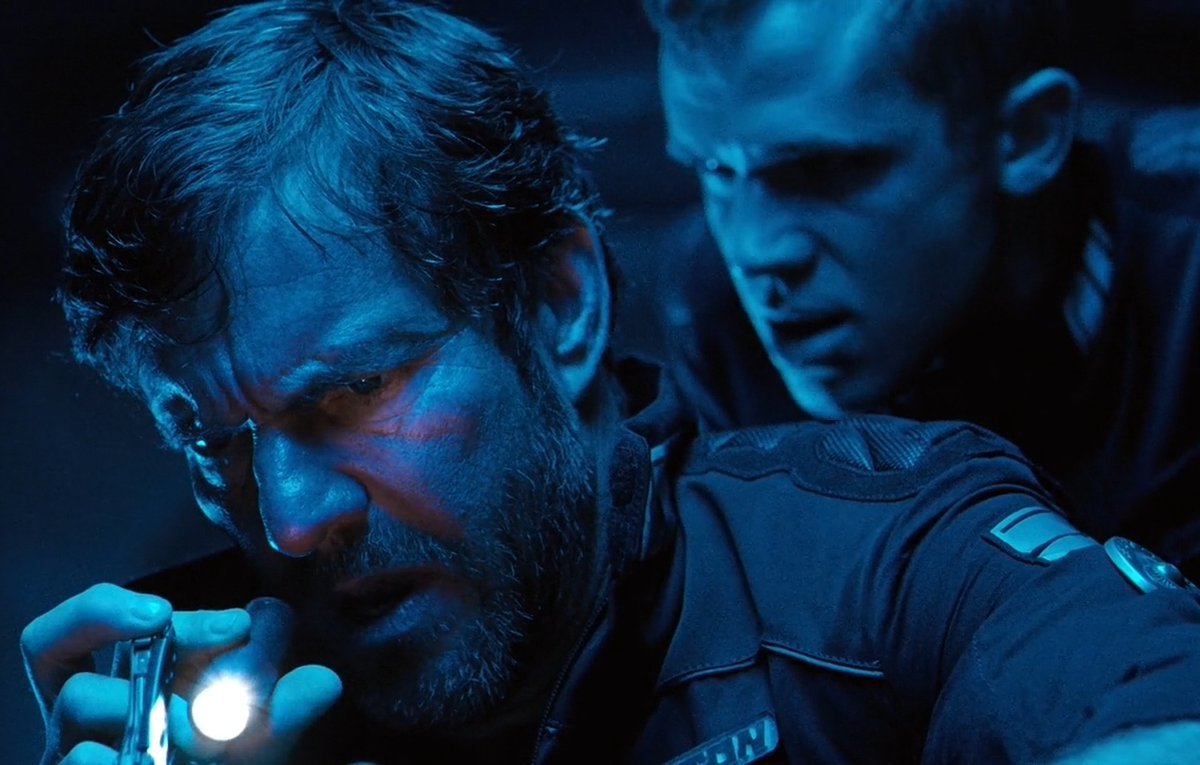Pandorum: A Signal Boost
What do you call an opening-weekend flop that barely made a quarter of its $33M budget in theaters? What do you call an action-horror-mystery-sci-fi-thriller with a Tomatometer score of 30% and a Metacritic score of 28? A film partially to blame in bankrupting its studio? Would you call it a failure? A disaster? You might call it a must-see masterpiece of genre-bending. A moody marvel of makeup, lighting, and set design shot in an abandoned power plant. A daring attempt to defy the formulaic filmgoer fodder churned out in droves. But, for now, we’ll simply call it Pandorum. Spoilers ahead.
The film occurs aboard an interstellar ark, Elysium, bound for the habitable planet Tannis in the year 3097. Two members of a flight crew wake with partial amnesia due to improper emergence from a machine hibernation called “hypersleep.” As they orient themselves, they discover their ship is in disrepair, its halls plagued with cannibalistic humanoids, and the few awakened passengers have devolved into a brutal survivalist microsociety. The two men must solve the mysteries of who they are and what happened as they race to repair the ship’s nuclear generator. All while maneuvering through legions of killers and conmen.
In just minutes on screen, Corporal Bower (Ben Foster) and Lieutenant Payton (Dennis Quaid) deduce what they can and then spring into action. A foundation of trust is quickly built on shared plight, mutual reassurance, and military decorum. Though the circumstances of their newfound friendship are perilous, Payton has an easy rapport with Bower, at one point teasing him about his claustrophobia in order to resolve a panic attack. This intimate but oblique emotional exchange is a superlative display of platonic male intimacy. Given everything else, we need this trust between them in order to go forward and as something to fall back on. The film is built on these early moments which seem small and insignificant. A lot of our own best relationships happen this way, in seemingly inconsequential moments. It’s a credit to Foster and Quaid’s performances that their friendship seems so real in such a short time.
The performances of such skilled actors sell our immersion in the strange, making it believable. They elevate every scene element: tension, wardrobe, special effects. Yes, even lighting—ever seen a heart-rending facial expression cast in long shadow? Horror tends to eschew name actors for budget consideration in favor of allocating funds to monsters, both CGI and mechanical, as well as elaborate kill scenes, fires, and explosions. However, Pandorum’s producers knew you get mileage from actors across scenes, as opposed to a ten-second fire that’s cool for two seconds after. We’d do well to remember, when budgeting dollars and cents, that actors can make or break a film. But, of course, the actors still exist within a larger framework. They still need to create their performances within a larger story, and, unfortunately, Hollywood remains capital-O obsessed with template structure. It’s branded and touted every which way by people happy to take your money to explain it to you: equilibrium until inciting incident at page and minute 10, central question at page and minute 17, first act break at page and minute 30—I’m not overstating the rigidity. It’s a proven and recognizable check-the-box cathartic cycle dating back to Aristotle, they say, mapping it onto all your favorite films. The worst part is there’s truth to it. Many good successful films trace this pattern. No finance executive wants to risk breaking precedent, not with their career and reputation at stake. Ergo, we have entered the age of remakes, remasters, and sequels. It begs the question: what stories are we missing as a result? Stories like Pandorum, among others.
Writer Travis Malloy’s plot deviations show there’s room for writers and directors to play. He wrote a preliminary script which producers Paul W.S. Anderson, Jeremy Bolt, and Robert Kulzer brought to director Christian Alvart. The director, who’d written a similar script, suggested they combine their work into the screenplay that became the blueprint for Pandorum. Rather than the visible seams of this graft hurting the film, they actually keep things interesting and innovative.
Few other films have such powerful or original climaxes, reveals, or reversals, and Pandorum has enough to make Chinatown feel linear. Here are four, any of which could carry the plot of a film. One, the emotional whiplash of the romantic subplot. Bower risks his life for the better part of an hour searching for his wife only to finally remember she never boarded the ship. She remained on Earth, which was destroyed, and died hundreds of years ago while he was asleep. Two, the cannibalistic mutants, not aliens, began as passengers. An enzyme in the ship’s food was designed to speed human adaptation on a new planet but, through generations of breeding, passengers evolved to the dark food-scarce environment of the ship. Three, when the crew finally open the shutters in the Bridge, they see only blackness. Where in outer space can they have gotten beyond the light of the stars? Then they see a flicker of bioluminescence. Followed by other aquatic life. They’re beneath the ocean of Tannis, their destination planet, and have been for 800 years. They already completed their journey and have been needlessly suffering for centuries. Four, Payton is actually Gallo, one of the crew that was awake during Earth’s destruction and final transmission. The knowledge drove him mad. He slaughtered the rest of the shift crew and created the atrocities on the ship. He’s unrecognizable as Gallo because he aged from being out of hypersleep for so long. But he returned to hypersleep when he grew bored of mayhem. Honestly, we’re not surprised. We’ve been trained by films like Fight Club and The Sixth Sense to jump to conclusions about unreliable narrators. Plus, the clues are all there. You can catch a glimpse of Payton’s forearm tattoo at several points. Pause, and you can read that he belongs to Flight Team 2, not 5. Additionally, he has much more skin and nutrient-plaster hugging his body when he first emerges, suggesting longer hypersleep. Reveals are only satisfying when an attentive viewer is rewarded with the opportunity to discover the truth for themselves. Seeding these clues fulfills the condition audiences demand of all good endings: to be surprising, but inevitable. All four of these twists check both boxes.
The script deviates from Hollywood norms in smaller ways as well. Watching, you’ll notice that we never actually get Nadya, Manh, or Leeland’s names until the credits. It's a feature, not a bug, that the characters are so thinly sketched. Bower doesn't get to know them, so neither do we–the speech isn’t even translated if you enable subtitles. It's all building to us having our minds further aligned with his. For instance, Manh has no shortage of lines, despite speaking only Vietnamese. Many screenwriters would have established that they can’t communicate with one another and then dismissed further attempts as redundant. But that isn’t flavorful or realistic. Manh is constantly trying to warn the others and explain the situation to no avail. Most of his characterization, thus, comes from selfless courage, where he is the definite lead in action choreography.
For one last subversion, Bower floods the ship, wiping out Gallo, the mutants, and their barbaric world, while triggering the failsafe ejection of all remaining pods. As viewers, we know none of the dormant settlers will have any knowledge of the horrible events that transpired. He erases the past instead of memorializing it. Maybe it’s best that much of history is lost to us; maybe it’s required for the future to have a chance. Don’t be surprised to find yourself meditating on the fragility of life and the chaotic nature of the universe. How lackadaisical something like mass extinction can be to the endless black void. It’s a sobering reminder about the fallacy of human significance for anyone brave enough to sit with the thought.
So, what remains now for Pandorum? What legacy? What continued existence? Will it sink into forgotten obscurity? Will it serve as a tragic cautionary tale? Or, like other initially misunderstood science-fiction series, can it be revived by fan support like Firefly or The Expanse? Can it make its way into the ranks of now-campy horror/sci-fi mainstays such as The Thing, Invasion of the Body Snatchers, or Re-Animator? Certainly, it belongs to the traditions set forth by H.P. Lovecraft, in which mind-breaking revelations are the cost to pay for confronting cosmic horror among truly alien entities—beings that can’t be understood, explained, or reasoned with. In film, it’s preceded by Alien, another enclosed survival horror set in space with creatures that make poor conversationalists. Approach with an open mind, and you’ll see that genre-fusing organic storytelling breaks Hollywood molds to make Pandorum truly one of a kind. Initially, it was conceived as a trilogy, though that hardly seems in the cards anymore. If you’re among the hopeful few wishing for the day, you can find fellows in the Facebook group Fans for PANDORUM Sequel, which includes writer Malloy and director Alvart. So what do you call a film like Pandorum? Experimental? Underrated? Meh? Watch it and let me know in the comments below.





David was raised by his single-mother's Blockbuster card. His first job was sweeping popcorn at an AMC theater. He still misses doing marquees and recording show times.